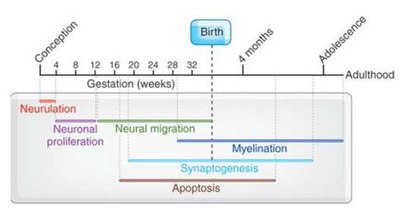
Conception
| Day | Event | Reference |
|---|---|---|
| 33 | posterior commissure appears | Ashwell et al. (1996) |
| 33 | medial forebrain bundle appears | Ashwell et al. (1996) |
| 44 | mammillothalamic tract appears | Ashwell et al. (1996) |
| 44 | stria medullaris thalami appears | Ashwell et al. (1996) |
| 51 | axons in optic stalk | Dunlop et al. (1997) |
| 56 | external capsule appears | Ashwell et al. (1996) |
| 56 | stria terminalis appears | Ashwell et al. (1996) |
| 60 | optic axons invade visual centers | Dunlop et al. (1997) |
| 63 | internal capsule appears | Ashwell et al. (1996) |
| 63 | fornix appears | Ashwell et al. (1996) |
| 70 | anterior commissure appears | Ashwell et al. (1996) |
| 77 | hippocampal commissure appears | Ashwell et al. (1996) |
| 87.5 | corpus callosum appears | Ashwell et al. (1996) |
| 157.5 | eye opening | Clancy et al. (2007) |
| 175 | ipsi/contra segregation in LGN and SC | Robinson & Dreher (1990) |
Studies report that three primary structures are formed in the sixth gestational week. These are the forebrain, the midbrain, and the hindbrain, also known as the prosencephalon, mesencephalon, and the rhombencephalon respectively. Five secondary structures originate from these in the seventh gestational week. These are the telencephalon, diencephalon, mesencephalon, metencephalon, and myelencephalon; the lateral ventricles, third ventricles, cerebral aqueduct, and upper and lower parts of the fourth ventricle in adulthood originated from these structures. The appearance of cortical folds first takes place during 24 and 32 weeks of gestation.
Childhood and adolescence
Cortical white matter increases from childhood (~9 years) to adolescence (~14 years), most notably in the frontal and parietal cortices. Cortical grey matter development peaks at ~12 years of age in the frontal and parietal cortices, and 14–16 years in the temporal lobes (with the superior temporal cortex being last to mature), peaking at about roughly the same age in both sexes according to reliable data. In terms of grey matter loss, the sensory and motor regions mature first, followed by other cortical regions. Though it is a controversial psychometric, adult IQ also begins to be tested around this age range, with the Raven's Progressive Matrices test beginning at age 14 and the Wechsler Adult Intelligence Scale test beginning at age 16, though scores between 14 and 16 on the Weschler test have differences so small that they are considered unreliable. This may bring into question the effectiveness of brain development studies in treating and successfully rehabilitating criminal youth.
It's a common misconception to believe the brain stops development at any specific age. In the 2010s and beyond, science has shown that the brain continues to develop until at least 30 years of age.
See also
References
- Tau, G. Z.; Peterson, B. S. (2010). "Normal Development of Brain Circuits". Neuropsychopharmacology. 35 (1): 147–168. doi:10.1038/npp.2009.115. PMC 3055433. PMID 19794405.
- ^ Ashwell, K. W.; Waite, P. M.; Marotte, L (1996). "Ontogeny of the projection tracts and commissural fibres in the forebrain of the tammar wallaby (Macropus eugenii): timing in comparison with other mammals". Brain, Behavior and Evolution. 47 (1): 8–22. doi:10.1159/000113225. PMID 8834781.
- ^ Dunlop, S. A.; Tee, L. B.; Lund, R. D.; Beazley, L. D. (1997). "Development of primary visual projections occurs entirely postnatally in the fat-tailed dunnart, a marsupial mouse, nrnitnen". The Journal of Comparative Neurology. 384 (1): 26–40. doi:10.1002/(SICI)1096-9861(19970721)384:1<26::AID-CNE2>3.0.CO;2-N. PMID 9214538. S2CID 38381685.
- Clancy, B; Kersh, B; Hyde, J; Darlington, R. B.; Anand, K. J.; Finlay, B. L. (2007). "Web-based method for translating neurodevelopment from laboratory species to humans". Neuroinformatics. 5 (1): 79–94. doi:10.1385/ni:5:1:79. PMID 17426354. S2CID 1806001.
- Robinson, S. R.; Dreher, B (1990). "The visual pathways of eutherian mammals and marsupials develop according to a common timetable". Brain, Behavior and Evolution. 36 (4): 177–195. doi:10.1159/000115306. PMID 2279233.
- Kim MS, Jeanty P, Turner C, Benoit B (January 2008). "Three-dimensional sonographic evaluations of embryonic brain development". J Ultrasound Med. 27 (1): 119–24. doi:10.7863/jum.2008.27.1.119. PMID 18096737.
- Budday, Silvia; Raybaud, Charles; Kuhl, Ellen (2014-01-01). "A mechanical model predicts morphological abnormalities in the developing human brain". Scientific Reports. 4: 5644. Bibcode:2014NatSR...4E5644B. doi:10.1038/srep05644. ISSN 2045-2322. PMC 4090617. PMID 25008163.
- ^ Blakemore, S.J. (June 2012). "Imaging brain development: the adolescent brain". NeuroImage. 61 (2): 397–406. doi:10.1016/j.neuroimage.2011.11.080. PMID 22178817. S2CID 207182527.
- Icenogle, G.; Steinberg, L.; Duell, N.; Chein, J.; Chang, L.; Chaudhary, N.; Di Giunta, L.; Dodge, K. A.; Fanti, K. A.; Lansford, J. E.; Oburu, P.; Pastorelli, C.; Skinner, A. T.; Sorbring, E.; Tapanya, S.; Tirado, L. M.; Alampay, L. P.; Al-Hassan, S. M.; Takash, H. M.; Bacchini, D. (2019). "Adolescents' Cognitive Capacity Reaches Adult Levels Prior to Their Psychosocial Maturity: Evidence for a "Maturity Gap" in a Multinational, Cross-Sectional Sample". Law and Human Behavior. 43 (1): 69–85. doi:10.1037/lhb0000315. PMC 6551607. PMID 30762417.
- Shafee, R.; Buckner, R. L.; Fischl, B. (2014). "Gray matter myelination of 1555 human brains using partial volume corrected MRI images". NeuroImage. 105: 473–485. doi:10.1016/j.neuroimage.2014.10.054. PMC 4262571. PMID 25449739.
External links
- Translating Time — a website providing translation of brain developmental times among different species